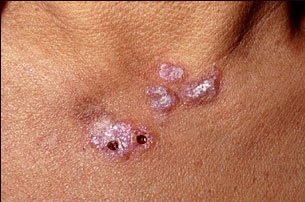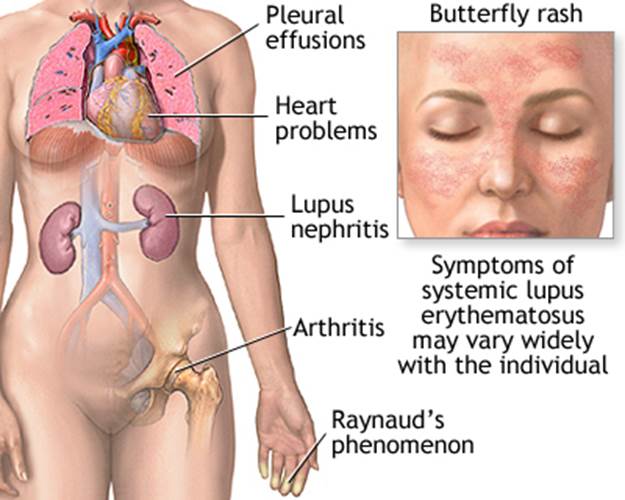Systemic lupus erythematosus
Systemic lupus erythematosus (SLE) is a disease that leads to long-term (chronic) inflammation.
Causes
Systemic lupus erythematosus (SLE) is an autoimmune disease in which the body's immune system mistakenly attacks healthy tissue. It can affect the skin, joints, kidneys, brain, and other organs.
The underlying cause of autoimmune diseases is not fully known.
SLE is much more common in women than men. It may occur at any age, but appears most often in people between the ages of 10 and 50. African Americans and Asians are affected more often than people from other races.
SLE may also be caused by certain drugs.
Symptoms
Symptoms vary from person to person, and may come and go. Almost everyone with SLE has joint pain and swelling. Some develop arthritis. The joints of the fingers, hands, wrists, and knees are often affected.
Other common symptoms include:
- Chest pain when taking a deep breath
- Fatigue
- Fever with no other cause
- General discomfort, uneasiness, or ill feeling (malaise)
- Hair loss
- Mouth sores
- Sensitivity to sunlight
- Skin rash -- a "butterfly" rash in about half people with SLE. The rash is most often seen over the cheeks and bridge of the nose, but can be widespread. It gets worse in sunlight.
- Swollen lymph nodes
Other symptoms depend on which part of the body is affected:
- Brain and nervous system: headaches, numbness, tingling, seizures, vision problems, personality changes
- Digestive tract: abdominal pain, nausea, and vomiting
- Heart: abnormal heart rhythms (arrhythmias)
- Lung: coughing up blood and difficulty breathing
- Skin: patchy skin color, fingers that change color when cold (Raynaud's phenomenon)
Some people have only skin symptoms. This is called discoid lupus.

Lupus, discoid - view of lesions on the chest: This close-up picture of the neck clearly shows the typical rounded appearance of discoid lupus. The whitish appearance is caused by scaling. The two dark spots are biopsy sites and are not part of the disease.
Exams and Tests
To be diagnosed with lupus, you must have 4 out of 11 common signs of the disease.
Systemic lupus erythematosus is a chronic inflammatory autoimmune disorder which may affect many organ systems including the skin, joints and internal organs. The disease may be mild or severe and life-threatening.
Your doctor will do a physical exam and listen to your chest. An abnormal sound called a heart friction rub or pleural friction rub may be heard. A nervous system exam will also be done.
Tests used to diagnose SLE may include:
- Antibody tests, including antinuclear antibody (ANA) panel
- CBC
- Chest x-ray
- Kidney biopsy
- Urinalysis
You may also have other tests to learn more about your condition. Some of these are:
- Antithyroglobulin antibody
- Antithyroid microsomal antibody
- Complement components (C3 and C4)
- Coombs' test - direct
- Cryoglobulins
- ESR
- Kidney function blood tests
- Liver function blood tests
- Rheumatoid factor
Treatment
There is no cure for SLE. The goal of treatment is to control symptoms. Severe symptoms that involve the heart, lungs, kidneys, and other organs often need treatment from specialists.
Mild forms of the disease may be treated with:
- NSAIDs, such as ibuprofen, for joint symptoms and pleurisy
- Corticosteroid creams for skin rashes
- An antimalaria drug (hydroxychloroquine) and low-dose corticosteroids for skin and arthritis symptoms
Treatments for more severe lupus may include:
- High-dose corticosteroids or medications to decrease the immune system response
- Cytotoxic drugs (drugs that block cell growth). These medicines are used if you do not get better with corticosteroids, or if your symptoms get worse when the stop taking them. Side effects from these drugs can be severe, so you need to be monitored closely if you take them.
If you have lupus, it is also important to:
- Wear protective clothing, sunglasses, and sunscreen when in the sun
- Get preventive heart care
- Stay up-to-date with immunizations
- Have tests to screen for thinning of the bones (osteoporosis)
Support Groups
Counseling and support groups may help with the emotional issues involved with the disease.
Outlook (Prognosis)
The outcome for people with SLE has improved in recent years. Many people with SLE have mild symptoms. How well you do depends on how severe the disease is.
The disease tends to be more active:
- The first years after diagnosis
- People under age 40
Many women with SLE can get pregnant and deliver a healthy baby. A good outcome is more likely for women who receive proper treatment and do not have serious heart or kidney problems. However, the presence of SLE antibodies raises the risk of miscarriage.
Possible Complications
Some people with SLE have abnormal deposits in the kidney cells. This leads to a condition called lupus nephritis. Patients with this problem may go on to develop kidney failure and need dialysis or a kidney transplant.
SLE can cause damage in many different parts of the body, including:
- Blood clots in the legs or lungs
- Destruction of red blood cells (hemolytic anemia) or anemia of chronic disease
- Fluid around the heart endocarditis, or inflammation of the heart (myocarditis)
- Fluid around the lungs and damage to lung tissue
- Pregnancy complications, including miscarriage
- Stroke
- Severely low blood platelet count
- Inflammation of the blood vessels
When to Contact a Medical Professional
Call your health care provider if you have symptoms of SLE. Call your health care provider if you have this disease and your symptoms get worse or a new one occurs.
Source: http://www.nlm.nih.gov/medlineplus/ency/article/000435.htm


